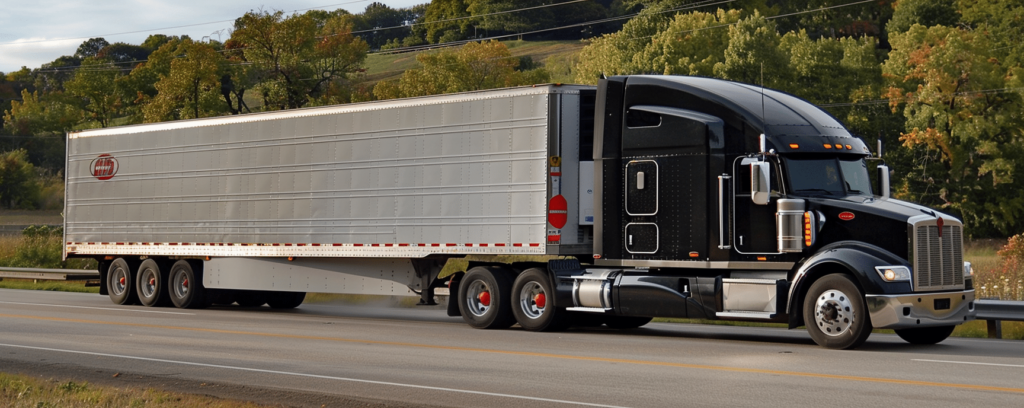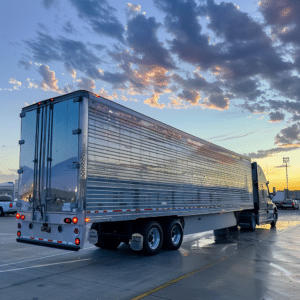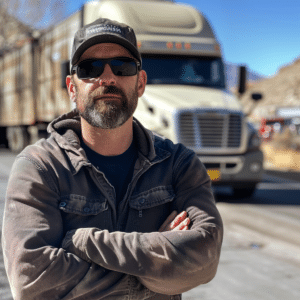What a Jackknife Truck Means and How to Prevent It?
Last updated Friday, December 20th, 2024

Have you ever wondered what a jackknife truck means? This term describes a perilous event where a truck’s trailer and cab create a sharp angle, akin to a partially folded pocket knife, with potentially disastrous results. Our exploration begins with understanding this frightening moment on the road, and its causes, and unfolds into prevention strategies and legal advice for those affected.
Key Takeaways
- A jackknife truck accident occurs when a semi truck’s cab and trailer fold at the hitch point due to loss of traction, which can be caused by factors like improper loading, equipment failure, and braking issues.
- Key preventative measures against jackknifing include proper loading and balancing of trailers, regular maintenance checks, especially of brakes and tires, and adherence to safe driving practices to ensure vehicle control.
- In case of a jackknife incident, victims should immediately seek legal representation to navigate the complex aftermath, determine liability, and secure fair compensation for damages incurred.
Decoding the Jackknife Phenomenon in Trucking
The term ‘jackknife’ vividly describes the acute folding that occurs when a semi truck’s cab and trailer disastrously lose their harmonious motion. When a truck loses traction with the road, the trailer can swing toward the cab in a perilous embrace, all in the blink of an eye. The ensuing chaos not only poses a threat to the truck driver but to everyone in the immediate vicinity. It’s a phenomenon characterized by a catastrophic loss of control, as the semi-truck’s cab and attached trailer fold at the point of attachment.
There are two types of jackknifing – the ‘trailer jackknife’ and the ‘tractor jackknife.’ The former occurs when the trailer brakes lock while the cab continues to move, and the latter happens when the tractor brakes lock, propelling the trailer forward. Both scenarios result in the trailer exerting force on the cab, culminating in the truck folding at the hitch point. A comprehension of these dynamics sheds light on the severity and suddenness of a jackknife truck accident.
Anatomy of a Jackknife Truck Accident

Such vehicular contortions often start when:
- the front vehicle skids
- the back trailer, unfazed by the cab’s struggles, maintains its momentum
- causing the cab to be pushed against its intended path.
The Role of the Trailer Swing
In this tragic play, the trailer’s swing, significantly influenced by the vehicle’s weight distribution, is a pivotal actor. An improperly loaded or overly heavy trailer amplifies the risk of sway, which becomes increasingly difficult to manage at higher speeds. This improper balance can lead to the trailer’s tail swinging out, especially when equipment failures, such as commercial trailer tires locking up, occur while the tractor remains in motion.
Such events underscore the importance of proper loading and the grave consequences that can follow when it’s neglected.
When the Rear Trailer Takes the Lead
When the rear trailer seizes control from the truck driver, it sets the stage for a potential jackknife – a dangerous turn of events. This critical moment is marked by the rear trailer traveling at a faster pace than the semi-truck cab, effectively dictating the direction of the entire truck.
It’s a hazardous situation where the trailer’s momentum can overpower the driver’s ability to steer the cab, leading to a dreaded jackknife scenario.
Contributing Factors to Truck Jackknifing
To prevent these accidents, it’s paramount to understand the contributing factors to truck jackknifing. A jackknife can occur when the cab’s drive tires lock up, while the trailer continues forward, especially during sudden braking on wet roads. This is exacerbated when trailers are empty, a condition known as ‘deadheading,’ which results in less road traction and increases the likelihood of truck jackknifes.
Additionally, driver actions such as excessive speeding can lead to difficulty in braking, causing the brakes to lock up and the trailer to swing uncontrollably. A perfect storm for a jackknife truck accident can be created by a combination of environmental conditions and human error.
Hazardous Road Conditions
The stage for a jackknife accident is often set by the environment itself. Slippery roads present a significant risk for truck jackknifing, with heavy rain or snow impairing visibility and reducing traction. Icy roads are particularly treacherous, as the lack of grip can cause trucks to skid uncontrollably. Such conditions demand careful and progressive braking to prevent jackknifing, a technique particularly crucial on slick or frozen surfaces.
Driver Error and Negligence
Apart from environmental challenges, driver error and negligence play a substantial role in jackknifing incidents. Abrupt braking can cause loss of traction, prompting the trailer to push against the cab, while speeding makes it difficult to brake suddenly without locking up the brakes.
Negligence, whether due to speeding, failure to maintain the vehicle, or driving while impaired, was a factor in a significant portion of total crashes and fatalities in 2020. Drivers are advised to adjust their speed for turns and maintain a safe following distance for controlled braking, to avoid jackknifing.
Preventative Measures Against Jackknife Accidents
Preventing jackknife accidents necessitates taking proactive steps. Proper truck maintenance ensures that the vehicle is safe and functioning correctly, reducing the likelihood of a jackknife. Pre-trip inspections for tractor-trailers are not only mandatory but also crucial in identifying any conditions that might contribute to a jackknife.
Additionally, drivers should perform in-transit inspections during long drives and post-trip inspections at the end of journeys, to detect any new or overlooked issues that could lead to jackknifing.
Ensuring Proper Loading and Balance
Ensuring proper loading and balance of the trailer is a key strategy in preventing jackknife accidents. By distributing 60 percent of the load towards the front, the risk of trailer swing is minimized. Securing cargo properly maintains stability and helps control trailer sway, which is crucial in avoiding potential jackknife accidents.
Heavier loads can actually increase grip on the road, thus reducing the chances of a trailer swinging out and causing a jackknife.
Regular Maintenance Checks
As a critical measure against jackknifing, regular inspections form the backbone of truck safety. Identifying and remedying mechanical defects like tire blowouts and brake failures are essential to maintaining control and preventing jackknifing. The braking system requires particular attention, including the function of anti-lock brakes and load-sensing regulators, which are vital for steering control.
Connection and stability controls, such as the fifth wheel and swing-limiting devices, should also be installed and maintained regularly to ensure a secure tractor-trailer connection and reduce the risk of jackknifing.
Legal Implications and Seeking Help
The complexity of navigating the aftermath of a jackknife truck accident can match that of understanding the mechanics behind the accident itself. Therefore, victims should seek the assistance of experienced truck accident attorneys to represent their interests and secure compensation for injuries and losses. An experienced jackknife truck accident lawyer can provide invaluable guidance post-accident, helping victims understand their rights against insurance adjusters’ tactics.
Compensation for damages including medical expenses, lost wages, and pain and suffering can be pursued with the help of legal representation.
When to Contact a Truck Accident Law Firm
Especially when significant damages or injuries are involved, it’s imperative to contact a truck accident law firm without delay following a jackknife truck accident. Legal counsel ensures a thorough investigation of the crash, which can be pivotal in determining liability and pursuing fair compensation. It’s also crucial in cases where there’s a dispute over fault, as trucking companies are often equipped with legal teams dedicated to minimizing their liability.
Victims who have suffered losses need the support of a law firm to navigate complex insurance claims and settlement negotiations. Proactive contact with a law firm provides the necessary support and guidance to protect victims’ rights.
Identifying Potential Compensation

- Family members of deceased victims can seek compensation for the loss of financial support and the loss of relationships.
- The deceased victim’s estate can pursue compensation for medical expenses.
- The deceased victim’s estate can pursue compensation for lost future income.
- In some cases, the deceased victim’s estate can pursue compensation for pain and suffering endured before death.
Claiming non-economic damages, such as emotional distress, is possible but requires strong evidence and testimony. Attorneys may target the trucking company in lawsuits to secure higher compensation due to their substantial resources and insurance policies.
Safety Tips for Other Drivers Sharing the Road with Large Trucks
Heightened awareness and adherence to safety protocols are necessary when sharing the road with large trucks. Overtaking a truck should be done quickly and cautiously, always maintaining a safe distance, particularly in scenarios that may require a sudden stop. Vigilance is key when driving near trucks, as unexpected events like tire blowouts can occur.
High beams should be avoided when behind or passing large trucks to prevent blinding the driver and increasing the risk of an accident.
Keeping a Safe Distance
Especially when following trucks that may jackknife, it’s paramount to maintain adequate spacing between vehicles. A safe following distance, typically allowing at least 4 seconds of reaction time, is crucial for minimizing the risk of a collision. This distance should be adjusted based on speed, road conditions, and the driver’s ability to respond to sudden truck movements.
Adverse weather conditions or the sheer size of larger vehicles, which may require more time to slow down or stop, necessitate even greater following distances.
Avoiding Blind Spots
Maneuvering around semi trucks requires a conscious effort to stay out of their blind spots. Trucks have significantly larger blind spots than passenger vehicles, and being unseen by the truck driver can lead to serious safety risks.
A simple rule of thumb is to ensure you can see the truck driver’s face in their side mirror; if not, the driver likely cannot see you, and it’s best to adjust your position on the road.
Frequently Asked Questions
What causes a truck to jackknife?
A truck can jackknife due to factors such as loss of traction, improper braking, excessive speed, slippery roads, and driver errors like sudden maneuvers or distracted driving. These factors can lead to dangerous situations on the road.
How can I prevent my truck from jackknifing?
To prevent your truck from jackknifing, ensure regular maintenance, proper loading, balanced weight distribution, cautious driving, and thorough inspections, especially in challenging weather conditions.
When should I contact a lawyer after a jackknife truck accident?
You should contact a truck accident lawyer immediately after a jackknife accident, especially if there are substantial injuries or disputes over fault. Legal counsel will help with investigating the crash and seeking fair compensation.
What compensation can I seek after a jackknife truck accident?
After a jackknife truck accident, you can seek compensation for medical expenses, lost wages, emotional distress, and loss of financial support and relationship in the case of a fatality. These are all important aspects to consider when seeking compensation for such an event.
How can other drivers stay safe around large trucks?
To stay safe around large trucks, other drivers should keep a safe distance, avoid blind spots, be cautious of sudden occurrences like tire blowouts, and pass trucks quickly and carefully on the left side while avoiding using high beams. This will help ensure everyone’s safety on the road.











